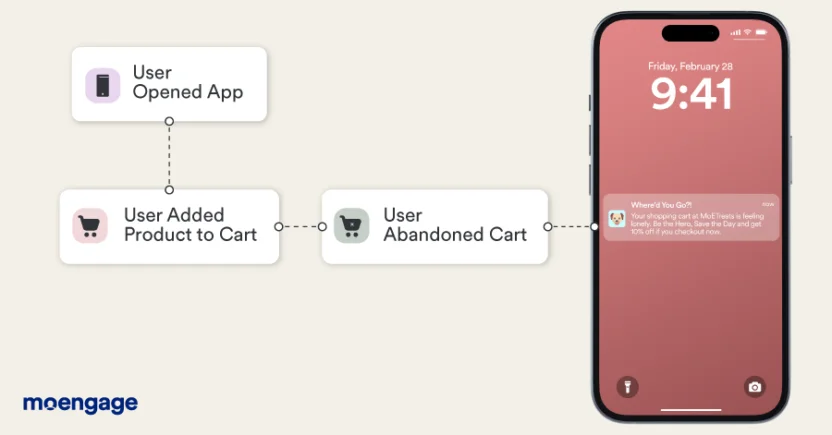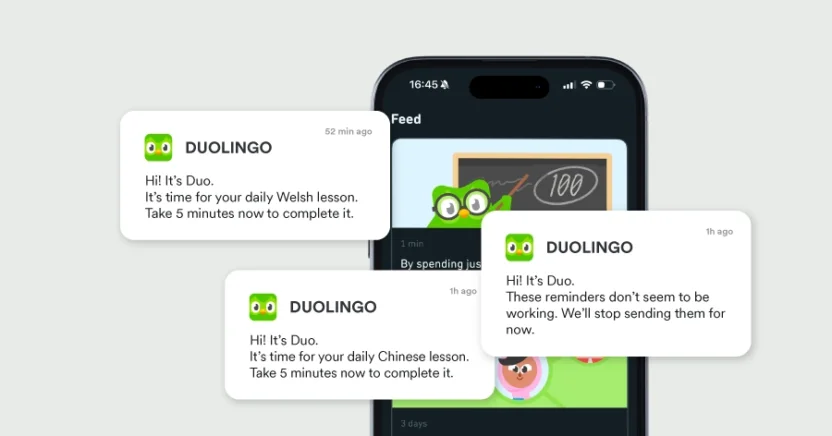How to Automate Push Notifications

Reading Time: 8 minutes
Many brands miss out on big opportunities for customer interaction simply because they do not know how to automate push notifications. Whether it’s a quick reminder for an overdue bill or an ongoing promotion, push notifications can be game-changers for brand engagement.
These notifications have tremendous potential to communicate quickly with customers. In fact, push notifications can deliver a 3500% ROI—that’s huge! This makes them a necessity for B2C marketers today.
Using these notifications, brands can send personalized recommendations to customers based on their location, behavior, or preferences, enhancing conversion rates.
Now imagine doing all of this manually. Doesn’t make sense, right? Marketers who know how to automate push notifications understand that doing so manually is not only labor-intensive but can also be unreliable.
That’s why we’re going to share the push notification automation use cases and implementation best practices in this article.
What is Push Notification Automation?
Push notification automation is the process of setting up messages to be sent automatically to customers based on how they interact with your brand, ensuring well-timed notifications. For example, an automated mobile push notification can be sent to a customer an hour after they have abandoned their cart.
Understanding how to automate push notifications doesn’t just allow sending text messages but also rich media and call-to-action buttons. What’s more, brands can send customized messages at scale to different customer segments based on demographics, preferences, and behavior. With automation, you can also do A/B testing and run multiple campaigns at the same time.

Need more reasons to learn how to automate push notifications? Keep reading to understand the benefits.
7 Benefits of Automating Push Notifications
Data suggests that customers receiving weekly notifications had 440% higher retention rates than those who did not receive any. The number rose to a whopping 820% for daily notifications! Here’s a look at some tangible benefits of automating mobile and web push notifications.
1. Reduces time and effort
Manually sending messages can be time-consuming and repetitive, costing your brand precious time that could be used elsewhere. Automating push notifications can lower the burden on the team to stay “always online” and send timely notifications. But when the team knows how to automate push notifications, all it takes is smart scheduling.
2. Re-engaging with inactive customers
Not all your customers may open the app frequently. Automated rich push notifications do wonders for re-engaging with such customers. Brands can consider sending out promotional offers or reminders to inactive customers to bring them back on their platforms. For example, you can send an automated push notification to a newly-onboarded customer who has not opened the app for a week after signing up.
3. Targeting through segmentation
Automated push notifications simplify sending messages targeted to specific customer segments. This is because your automation platform takes care of classifying user segments based on characteristics you define. And your messages become more relatable for customers!
For instance, you can send messages about the launch of your new-age sneakers to specific age groups, such as teens, who are more likely to explore those sneakers.
4. Multiple campaigns at once
With automated push notifications, running multiple campaigns simultaneously can be a breeze. Rather than manually sending out notifications, marketers can learn how to automate push notifications and simply set up simultaneous campaigns, A/B test them, and run them automatically. Automation also simplifies the process of monitoring the performance of multiple campaigns using push notification metrics.
5. Well-timed and quick messaging
Gone are the days when you needed to stay hooked to the screen to send notifications. Automation can take care of sharing push notifications at predefined times. A specific use case can be drip campaigns, where messages are immediately triggered when a customer performs a specific action. A series of scheduled messages that are timed based on the customer journey can make a world of difference when it comes to engagement.
6. Efficiency and reliability
The cost of sending an ill-timed message or one ridden with mistakes can be huge for a brand. While your eyes may fail you, automated testing enables frequent testing and early detection of issues.
7. Scalability
Your goal might be to grow your app users. But with a rising user base, your problems with manual push notifications will only multiply. Automation can help you scale effortlessly, sending out personalized messages to a wide and diverse user base.
Now that you know all the benefits of automating push notifications, let’s get straight to the low-down of how to automate push notifications.
How to Automate Push Notifications
Automating push notifications is easy. All you need to do is follow these simple steps.
1. Choose a push notification platform
Most push notification platforms have everything lined up in one place. Explore different platforms and choose one that aligns with your brand’s objectives. Platforms like MoEngage allow messaging and viewing real-time insights from a single dashboard.
2. Connect it with your app
Connect your app with the push notification platform via APIs.
3. Segment your audience
Segment your audience based on various parameters like app usage patterns, age, gender, customer type, interests, and so on to send them customized notifications.
4. Create notification templates
Prepare your notification templates suited for each target segment and save them on the platform. These may be of different types, such as transaction alerts, reminders, promotions, and welcome messages.
5. Schedule your messages
Once you have your templates ready, all you need to do is decide the trigger conditions when your automated push messages will be sent to customers. Triggers can be events such as an abandoned cart, payment reminders, or specific time intervals of inactivity.
6. Test, monitor, and optimize
Once you’ve set up your automated push notification campaign, consider testing your messages to ensure you have set the proper controls. Monitor traction and response on your current automated push campaigns and refine them as necessary.
So, you can see it’s not that hard when you have the right platform backing you! Let’s get to know some common use cases where you can automate push notifications.
Common Use Cases for Automating Push Notifications
As seen above, push notifications definitely add more power to your marketing arsenal. They can help improve retention and enhance customer conversation rates by leaps and bounds. When it comes to your notifications, they can either be regular reminders (such as daily, weekly, or monthly) or event-based triggers (such as overdue payment or abandoned cart for “x” number of hours). Learning how to automate push notifications can make this easy!
Here are some examples:
1. Onboarding notifications
When a new customer signs up on your app, you can automate push notifications to send them a welcome message and get them more involved. Brands witnessed nearly 3x higher retention rates when customers received push notifications in their first 90 days of using the app vs. those who did not receive any notifications. This finding makes it even more crucial for brands to send out introductory notifications and more importantly learn how to automate push notifications.
You can use welcome notifications to direct users to explore the app or nudge them to take the next steps, such as completing their profile.

2. Transactional notifications
Automated transactional notifications can keep customers assured on their purchase journey. These messages can be sent for order confirmations, payment status, and even shipping and delivery updates.

3. Offers and discounts
Running special offers for selected customers? Or a holiday sale for all customers? Communicating these offers via automated push notifications can quickly drive your sales.
Did you know that five out of six businesses already use push notifications to announce promotional offers? It’s also interesting to note that around 52% of customers look for relevant information and offers when they receive push notifications.
Marketers can cleverly combine personalized push notification marketing with automation to target specific user segments, such as customers who have browsed particular products in the last week.
4. Announcing new products
What’s the quickest way to inform users of a new product launch? Send this information straight to their screen with push notifications! Knowing how to automate push notifications in this case can be one of the most critical tactics for brands to increase product awareness.
5. Re-engagement notifications
Inactive customers on the rise? Remind them to return to your app with enticing automated notifications.
The example below shows how brands can smartly use push notifications based on users’ activity levels. Duolingo seems to have grasped how to automate push notifications based on user interaction to boost re-engagement.

This may also include user behavior-based notifications. For instance, brands might target someone who has clicked on a certain product page or left a specific course midway.
6. Time and location-based notifications
Your brand might be headquartered in the US, but you might need to message customers in Australia. Automated time and location-based push notifications can accommodate differences in time zones and locations by allowing you to schedule campaigns beforehand.

7. Cart abandonment notifications
One of the most essential uses of automated push notifications is targeting customers who have left the purchase journey after filling their cart. When they’re just one step away from a purchase, sending them automated notifications for this event has a high chance of conversion. On average, abandoned cart push notifications receive a 10-15% click-through rate, which may show that many users revisit their carts after receiving a notification. What’s more, perfecting how to automate push notifications in these scenarios can be game-changing for brands.

8. Special occasions
There is no better way for your brand to connect with customers than by showing them you care. A simple way to do so is to send them personalized wishes or offers on special occasions like their birthday or anniversary. Why? Nearly nine out of 10 industry professionals say customers expect personalized content from brands. So, if you use this tactic, your brand will surely win some brownie points!
Sending personalized notifications can go a long way toward making customers feel special. Push notifications can also use rich, attractive media to better engage customers.
9. Creating FOMO
Creating a sense of urgency among prospective buyers is another way to boost sales.
Be it making a personalized offer for a new customer, a wishlist item, items left in the cart, or even a product launch, automated push notifications can nudge the customer toward your brand’s goal.

There are many more use cases when it comes to automated push notifications. These include upselling, cross-selling, recurring notifications, brand loyalty program notifications, and so on. The question is whether your brand is leveraging this tactic to the fullest!
10. Informational Updates
Awareness plays a key role in how customers perceive your brand. You can use automated push notifications to inform customers about your products and services, the latest industry insights, and more.

Push Notification Automation: Concluding Thoughts
There’s no better feeling than confidently having your push notification messaging strategy on autopilot. Automated push notifications can be that missing piece in your marketing strategy jigsaw that can take engagement, retention, and conversations up several notches. Concocting a concise, visually appealing message with a touch of personalization can shower your brand with a plethora of benefits.
That being said, it’s time to learn how to automate push notifications easily with MoEngage, so you can send personalized push notifications at scale.
So, what are you waiting for? Discover the power of automating push notifications in full throttle with MoEngage’s push notification platform.
Or get a firsthand experience of the platform with a comprehensive demo today.














